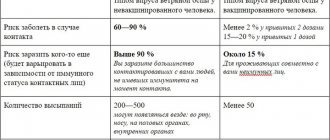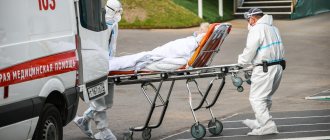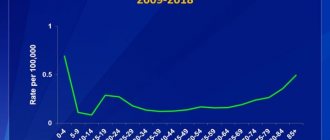Composition of the drug
The vaccine is a yellow-white homogeneous suspension, which, when settled, separates into a transparent component and a sediment that is distributed after shaking.
Bubo-Kok contains:
- recombinant yeast surface antigen of hepatitis B virus;
- pertussis bacteria inactivated with formalin;
- diphtheria and tetanus toxoids, purified from ballast (protein compounds).
The preparation also contains aluminum hydroxide and preservative merthiolate.
Release form and composition
Dosage form – suspension for intramuscular (IM) administration: homogeneous, yellowish-white; during storage, it separates into two layers - a colorless transparent liquid and a loose yellowish-white sediment, which, when shaken, is completely broken [0.5 mg (1 dose) in ampoules, 10 ampoules in strip packs, 1 pack in a cardboard box, ampoule knife and instructions for use Bubo-Kok (when using ampoules with break points, the ampoule knife is not inserted)].
Composition of Bubo-Kok per 1 dose (0.5 ml):
- active components: diphtheria toxoid - 15 Lf (flocculating units), tetanus toxoid - 5 EC (binding units), pertussis bacteria (Bordetella pertussis) - 10 billion, HBsAg (HBS protein, which is the main surface antigen of the hepatitis B virus) - 5 mcg ;
- excipients: aluminum hydroxide (Al3+) - 400 mcg, merthiolate (preservative) - 50 mcg.
Mechanism of action and benefits
The action of the Bubo-Kok vaccine is aimed at developing the child’s immune defense. After vaccination, the components of the drug enter the bloodstream, simulating infection. The body responds by producing antibodies, interferons and phagocytes. A noticeable increase can be observed within two weeks after the administration procedure.
As a result, the child’s leukocytes “get acquainted” with infectious agents, and in the event of a real infection with diphtheria, whooping cough, tetanus or hepatitis B, the immune system will be able to defeat the disease.
The use of combination drugs has a number of advantages:
- the stress load on patients is reduced;
- vaccination is carried out according to the time limits specified in the vaccination calendar;
- the workload on nurses, pediatricians and other medical facility specialists is reduced;
- financial costs for immunization are reduced.
The combined drug Bubo-Kok is similar in content of active components to DTP and the hepatitis B vaccine, but at the same time, merthiolate (preservative) and aluminum hydroxide gel (sorbent) enter the child’s body in smaller quantities than when two vaccines are administered.
Pharmacological properties
Pharmacodynamics
The Bubo-Kok composition is a mixture of tetanus and diphtheria toxoids, phase 1 pertussis microbes killed by formaldehyde, and recombinant surface antigen of the hepatitis B virus (HBsAg), adsorbed on aluminum hydroxide.
When the vaccine is administered according to the approved scheme, specific immunity is formed against tetanus, diphtheria, whooping cough and hepatitis B.
Pharmacokinetics
There is no information on the pharmacokinetics of the drug.
Vaccination schedule
Vaccination with Bubo-Kok can be carried out on children from 3 months to 4 years.
The vaccine is given according to the national calendar of preventive vaccinations at a time when it is planned to administer drugs against hepatitis B, tetanus, whooping cough and diphtheria at the same time.
A child who has not received a hepatitis B vaccine before 3 months of age is vaccinated three times according to the schedule of 3 -4.5 - 6 months. The intervals cannot be reduced. If it is not possible to carry out the procedure on time, then it needs to be done later, but as close to the schedule as possible.
There is a monovaccine Bubo-Kok against hepatitis B. It is used when a child has been vaccinated with LCDS, but has not received a vaccine against hepatitis B. Up to three procedures can be performed using this drug.
In cases where DPT revaccination is planned at the same time as vaccination against hepatitis B, Bubo-Kok can be used, even if the previous procedures were carried out using standard methods.
If the child is already 4 years old and has not been vaccinated with DTP or Bubo-Kok vaccines, then it can be done with the following drugs:
- LDS toxoid from 4 to 6 years (not including birthday);
- ADS-M toxoid from 6 years;
- Bubo-M, when DPT revaccination and hepatitis B vaccination are scheduled at the same time.
The Bubo-Kok vaccine can be administered together with other drugs provided for by the National Preventive Vaccination Calendar, or a month after vaccination against other infectious diseases. The drug can be used with anti-allergy medications.
Method and place of administration
The graft is placed inside the gluteal or femoral muscle. The single volume for administration is 0.5 ml. Before the procedure, the ampoule must be shaken to obtain a homogeneous suspension.
After opening, storing the ampoule is strictly prohibited. Also, you cannot use the drug if the integrity of the container has been damaged, if there are no markings, changes in color, flakes falling out, expiration date, or violation of storage rules.
Vaccination must be reflected in documents - special accounting forms, which indicate the batch number, expiration date, the name of the company that manufactured the drug, the date of vaccination and the body’s reaction to the procedure.
Bubo-Kok, instructions for use: method and dosage
Bubo-Kok is administered in accordance with the National Preventive Vaccination Calendar. The timing of vaccination should include simultaneous vaccination against tetanus, hepatitis B, diphtheria and whooping cough.
The suspension is injected intramuscularly into the upper outer quadrant of the buttock or into the anterior outer region of the thigh. A single dose is 0.5 ml. Before using the drug, the ampoule should be shaken well so that the suspension acquires a homogeneous structure.
Opening the ampoules, filling the syringe and the vaccination procedure must be carried out with strict adherence to the rules of antisepsis and asepsis.
After opening the ampoule, storing the vaccine is prohibited. Do not use the drug if the integrity of the ampoules is damaged, there is no labeling, there is a change in the physical properties of the suspension (changes in color, the presence of unbreakable flakes, etc.), improper storage or the expiration date has expired.
For children who have not been vaccinated against hepatitis B before 3 months of age, Bubo-Kok is administered three times: at 3 months, at 4.5 months and at 6 months.
The intervals between drug administrations cannot be shortened. If it is not possible to get the next vaccination at the prescribed time, the vaccine should be administered as soon as possible, determined by the child’s health condition.
For children who have not been vaccinated against hepatitis B and who have received one or two vaccinations with the DTP vaccine, the missing number of vaccinations up to three can be given with the Bubo-Kok vaccine, while the missing number of vaccinations against hepatitis B is carried out with the corresponding monovaccine.
With the help of DTP vaccine, revaccination against whooping cough, diphtheria and tetanus is done once at the age of 18 months (if the deadlines were violated, then 12-13 months after the end of the full course of vaccination). In cases where revaccination with the DPT vaccine coincides with the administration of the hepatitis B vaccine, it can be carried out with the Bubo-Kok vaccine.
The medical representative registers the administration of the vaccine in the established accounting forms, indicating the batch number of the vaccine, its expiration date and manufacturer, the date of vaccination, as well as the nature of the reaction to the administration of Bubo-Kok.
Note! Children who have not received booster vaccination with the Bubo-Kok or DPT vaccine before reaching 4 years of age are given the ADS-toxoid vaccine intended for ages from 4 years to 5 years 11 months 29 days, or the ADS-M-toxoid vaccine for ages 6 years and older. When revaccination against diphtheria and tetanus coincides in time with vaccination against hepatitis B, it can be carried out with the Bubo-M vaccine.
Contraindications
Absolute contraindications for vaccination with Bubo-Kok include:
- some disorders in the nervous system;
- afebrile convulsive manifestations;
- yeast allergy;
- pronounced negative consequences and complications after vaccines: DTP, Bubo-Kok, against hepatitis B.
If convulsions occur only at elevated temperatures, then it is possible to administer Bubo-Kok. In this case, after the procedure, paracetamol is prescribed for 24–48 hours.
A child who has suffered an acute illness is vaccinated a month after recovery. If a mild respiratory infection was observed (rhinitis, slight redness of the throat), then the vaccine can be given a couple of weeks after recovery.
For chronic diseases, vaccination is possible a month after remission is established. For stable allergic symptoms, vaccination is carried out in combination with targeted therapy. Read more: medical advice from vaccinations →
Body reactions
Normal reactions of the body to the administration of the Bubo-Kok vaccine are:
- short-term, gradually decreasing increase in total body temperature to 38.5 °C;
- malaise and weakness for 1–2 days after the procedure;
- muscle pain;
- soreness, redness and swelling at the injection site.
Complications are rare. These include:
- convulsions, often febrile;
- high-pitched scream;
- motor agitation;
- manifestations of allergies.
Due to the risk of allergic reactions, the child must be present at the clinic for half an hour after vaccination. In this case, at the first sign of a complication, immediate medical assistance will be provided.
Discontinuation of subsequent vaccination with Bubo-Kok is recommended in case of severe general reactions of the body (temperature more than 40 °C, swelling and redness of the injection site with a diameter of more than 8 cm), as well as if complications occur.
Bubo-Kok
Considering the possibility of developing immediate allergic reactions, vaccinated people must be provided with medical supervision for 30 minutes. Vaccination sites must be provided with anti-shock therapy.
If a pronounced general reaction develops after vaccine administration (hyperthermia over 40 degrees C, swelling and hyperemia over 8 cm in diameter at the injection site) or a post-vaccination complication, further vaccination is stopped. If the child has been vaccinated twice, the course of vaccination against diphtheria and tetanus is considered completed, and vaccination against hepatitis B is completed with a single monovaccine 1 month after the second Bubo-Kok vaccination. If the child has received one vaccination, vaccination can be continued with the Bubo-M vaccine, which is administered once no earlier than after 3 months. In this case, vaccination against hepatitis B is considered complete. In both cases, the first revaccination is carried out with ADS-M toxoid 9-12 months after the last vaccination with the Bubo-Kok or Bubo-M vaccine. If a complication develops after the third vaccination with the Bubo-Kok vaccine, the first revaccination is carried out with ADS-M toxoid after 12-18 months. Subsequent revaccinations are carried out at decreed ages with ADS-M toxoid.
With hyperthermia above 38.5 degrees C in more than 1% of vaccinated people or the occurrence of severe local reactions (swelling of soft tissues with a diameter of more than 5 cm, infiltration with a diameter of more than 2 cm) in more than 4% of vaccinated people, as well as the development of post-vaccination complications, vaccination with the drug of this series stop. The question of its further use is decided by GISC named after. L.A. Tarasevich.
The presence of febrile seizures during the previous dose of the vaccine is not a contraindication to subsequent doses; It is advisable to prescribe paracetamol (10-15 mg/kg 3-4 times a day) for 1-2 days after its administration.
Those who have suffered acute diseases are vaccinated no earlier than 4 weeks after recovery; in mild forms of respiratory diseases (rhinitis, slight hyperemia of the pharynx), vaccination is allowed 2 weeks after recovery.
Patients with chronic diseases are vaccinated no earlier than 4 weeks after achieving stable remission.
Stable manifestations of an allergic disease (including localized skin rashes, hidden bronchospasm) are not a contraindication to vaccination, which can be carried out against the background of appropriate therapy.
In order to identify contraindications, the doctor (paramedic) on the day of vaccination conducts a survey of parents and examines the child with mandatory thermometry. Children temporarily exempt from vaccination must be monitored and registered and vaccinated in a timely manner.
Opening of ampoules and vaccination is carried out in strict compliance with the rules of asepsis and antiseptics. The drug cannot be stored in an opened ampoule.
The drug is not suitable for use in ampoules with damaged integrity, lack of labeling, changes in physical properties (change in color, presence of unbreakable flakes), expired, or improperly stored.
What to do before and after vaccination
Preparing a child for immunization is very important, because vaccination with Bubo-Kok is a serious burden for a growing organism. Before routine vaccination, you need to go to an appointment with pediatric specialists, especially a neurologist, since children with neurological diseases often experience complications after the administration of the vaccine.
Taking tests (blood, urine) will confirm the absence of concomitant diseases that could negatively affect the child’s condition in the post-vaccination period. If a child is prone to allergies, then a few days before vaccination you need to start taking antihistamines in a prophylactic dose.
On the day of vaccination, the child must visit a pediatrician; he will conduct an examination to confirm the absence of concomitant diseases, for example, an incipient acute respiratory infection.
After vaccination, it is necessary to provide the child with plenty of fluids and not to insist on eating - loss of appetite is quite common.
It is important to monitor your temperature and general physical condition. If the temperature rises above 38 °C, you need to undress the child and wipe with a damp towel; if these measures do not help, give an antipyretic drug, for example, Nurofen.
At the first signs of complications (suffocation, convulsions, loss of consciousness), you should immediately call an ambulance. The doctor must be informed about the previous vaccination procedure and provide a vaccination certificate.
If the child feels well and there is no increase in temperature, you can adhere to the usual regimen, including swimming (but not rubbing the injection site) and walking.
Author: Olga Khanova, doctor, especially for Mama66.ru










